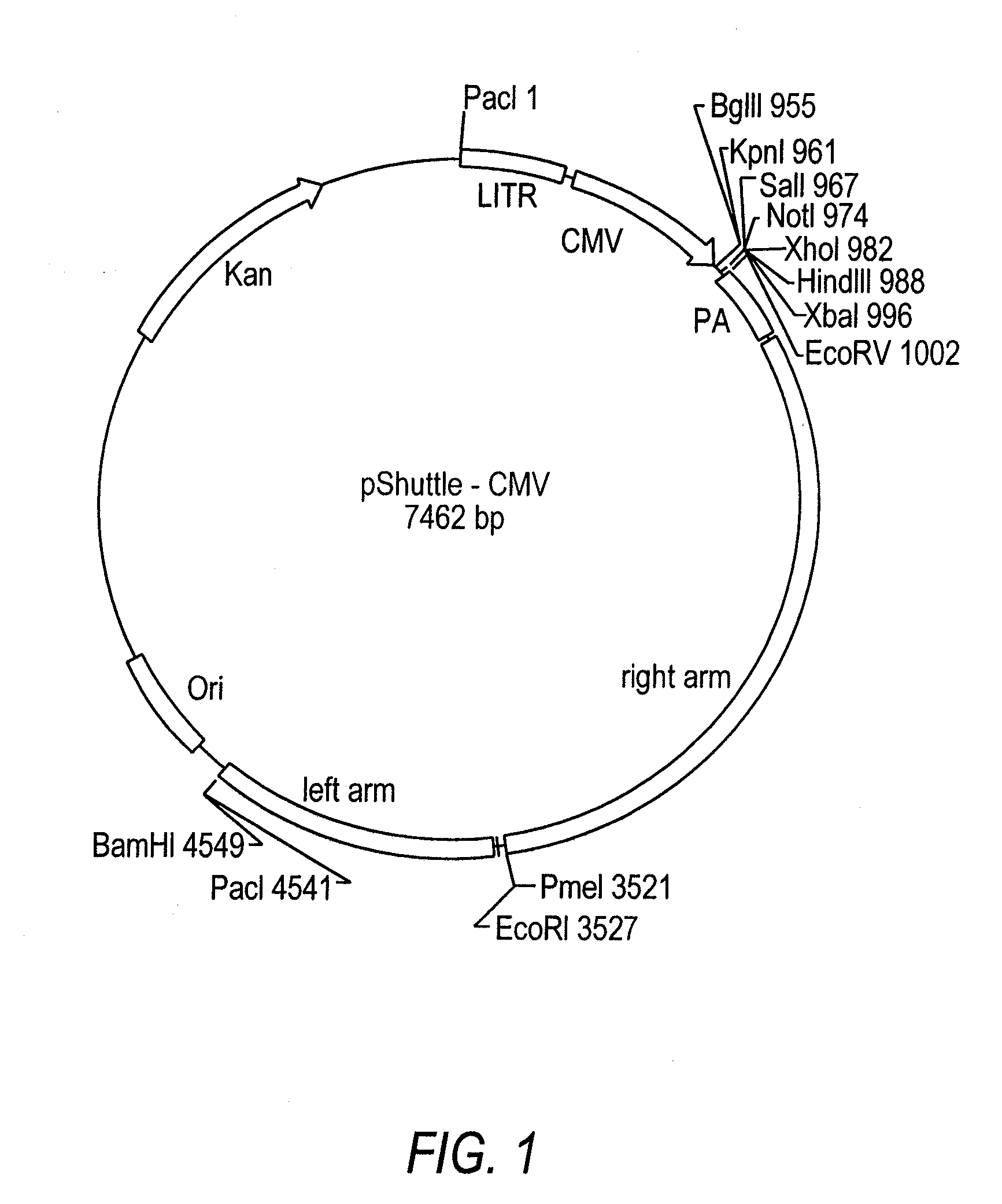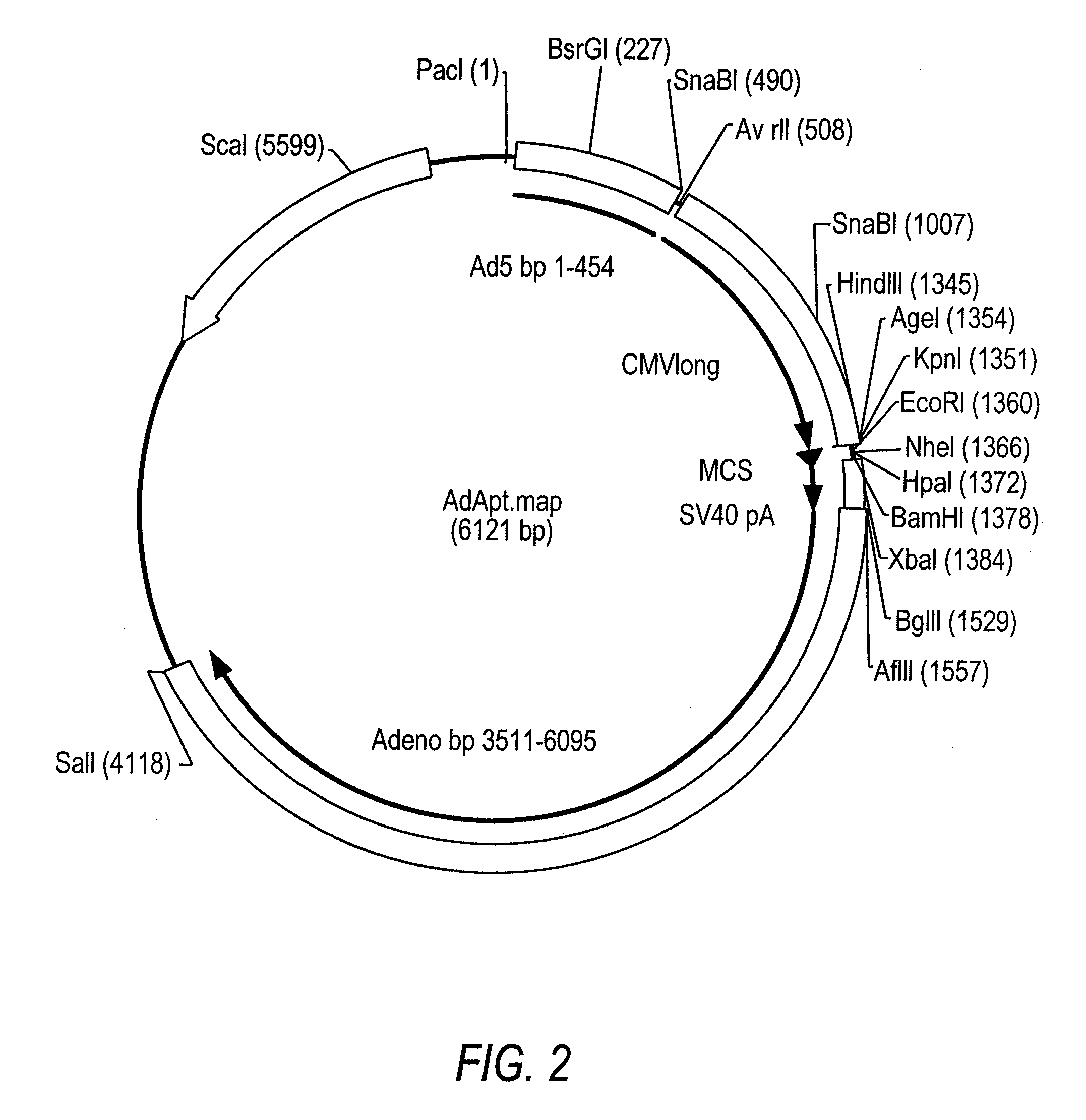System for rapid production of high-titer and replication-competent adenovirus-free recombinant adenovirus vectors
a technology of recombinant adenovirus and high-titer, which is applied in the field of immunology, gene therapy, vaccine technology, can solve the problems of limited vaccine production speed, crippling chicken farms, and shortage of influenza vaccines, so as to reduce production time and cost, and rapid production of influenza vaccines
- Summary
- Abstract
- Description
- Claims
- Application Information
AI Technical Summary
Benefits of technology
Problems solved by technology
Method used
Image
Examples
example 1
Production of a Replication-Defective Adenovirus Expressing Influenza HA
[0131]Two adenovirus (Ad) vectors encoding influenza HA were constructed using the AdEasy system. Two current influenza virus strains, [A / Panama / 2007 / 99 (H3N2) and B / Hong Kong / 330 / 01] that were selected for vaccine production in 2003-2004, were provided by The Centers for Disease Control and Prevention (CDC). The A / Panama / 2007 / 99 HA gene was cloned by reverse transcription of the influenza RNA, followed by amplification of the HA gene with polymerase chain reaction (PCR) using the following primers:
TABLE 1Primer Sequences for Amplification of Influenza GenesStrainPrimer SequenceA / Panama / 2007 / 995′-CACACAGGTACCGCCATGAAGACTATCATTGCTTTGAGC-3′5′-CACACAGGTACCTCAAATGCAAATGTTGCACC-3′B / Hong Kong / 330 / 015′-CACACAGGTACCGCCATGAAGGCAATAATTGTACTAC-3′5′-CACACAGGTACCAGTAGTAACAAGAGCATTTTTCAATAACG-3′
[0132]These primers contain sequences that anneal to the 5′ and 3′ ends of the A / Panama / 2007 / 99 HA gene, an eukaryotic ribosomal bind...
example 2
Construction of pAdHighα
[0136]Crucell's shuttle plasmid pAdApt was separately digested with restriction enzymes SgrAI+EcoRI, and BstXI+EcoRI. In parallel, the shuttle plasmid pShuttleCMV was digested with SgrAI+BstXI. The resulting pAdApt SgrAI-EcoRI and BstXI-EcoRI fragments were inserted into the SgrAI-BstXI site of pShuttleCMV by 3-way ligation, resulting in a replication defective Ad vector. The replication-defective Ad vector encoding the influenza HA gene (AdHighαPNM2007 / 99.H3) was generated by transfecting the recombinant plasmid into PER.C6 cells. Cytopathic effects (CPE) emerged approximately 7 days after transfection, within the same timeframe as that required for the AdEasy system in 293 cells (He et al., 1998).
example 3
Construction of pAdHighβ
[0137]To repair the defective sequences, pShuttleCMV's CMV promoter, the adjacent multiple cloning site, and flanking Ad sequences were replaced as one unit with their counterpart from pAdApt through homologous recombination, because these two shuttle plasmids share extensive overlapping sequences. However, a new marker was also required for selecting the recombinants. The full-length tetracycline (Tc) resistance gene (Backman and Boyer, 1983; Peden, 1983) from the plasmid pBR322 were amplified by PCR using primers 5′-GAGCTCGGTACCTTCTCATGTTTGACAGCTTATCAT-3′ and 5′-TCTAGAGGTACCAACGCTGCCCGAGATGCGCCGCGT-3′ with built-in KpnI sites. The amplified Tc gene was inserted into the KpnI site of the Amp-resistant plasmid pAdApt to generate a new plasmid pAdApt-Tc, which can be selected by applying both Amp and Tc to the growth medium.
[0138]The Ad sequence in pShuttleCMV was replaced with its counterpart in pAdApt-Tc using the high-efficiency AdEasier recombination proto...
PUM
| Property | Measurement | Unit |
|---|---|---|
| Electrical resistance | aaaaa | aaaaa |
| Immunogenicity | aaaaa | aaaaa |
Abstract
Description
Claims
Application Information
 Login to View More
Login to View More - R&D
- Intellectual Property
- Life Sciences
- Materials
- Tech Scout
- Unparalleled Data Quality
- Higher Quality Content
- 60% Fewer Hallucinations
Browse by: Latest US Patents, China's latest patents, Technical Efficacy Thesaurus, Application Domain, Technology Topic, Popular Technical Reports.
© 2025 PatSnap. All rights reserved.Legal|Privacy policy|Modern Slavery Act Transparency Statement|Sitemap|About US| Contact US: help@patsnap.com



